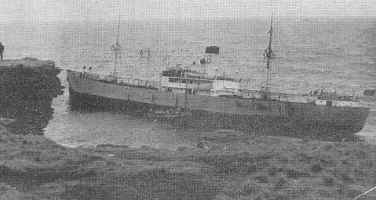|
"Swedish Cargo Ship Stranded At
Freswick."
After the Swedish cargo ship, Stellatus, ran aground
on a reef on the coast at Freswick, about a mile-and-a-half south of
Skirza Head, on Tuesday, Wick lifeboat took the master and crew of 25
off in two separate trips - one in the afternoon and the other in the
evening. The Stellatus (1800 tons) was still on the reef yesterday, (5th
March 1959), her position unchanged, as far as could be judged by
salvage experts who saw the vessel.
 |
(This picture is
reproduced from "The John O'Groat Journal" newspaper - with
kind permission.)
A close up of the ship - Wick
lifeboat is alongside - with the salvage tug Metinda III in the
background.
(Click on the picture to
enlarge.) |
Bound for Ellsmere Port, near Liverpool, with a cargo
of wood pulp from Obo, Finland, the Stellatus went aground during thick
haze between four and five o'clock in the morning. As she was in no
immediate danger, she did not want aid at first. The ship had run on a
reef under a high cliff a short distance south of the ruins of Buchollie
Castle, ancient seat of the Mowat family. It was almost high tide at the
time.
The vessel was lying parallel to the land, about 120
yards off shore. A fresh south-easterly wind was blowing, and, in case
of danger, Wick lifeboat was called out, under the command of Coxswain
Neil Stewart. Wick Coastguards, with District Officer James Addison in
charge, and life saving apparatus crew were also summoned.
The Wick seine-net boat, Starlight (Skipper George
Sinclair), on her way to the west, was first to arrive at the ship and
stood by for some time. When the lifeboat arrived, she took up position
on the leeward side of the Stellatus - between the ship and the rocks.
From the clifftop the coastguards succeeded in
getting a line aboard the stranded vessel at the second attempt. Mr.
Addison said: "With the first shot the wind carried the line past
the ship, but the second one fell over her stern."
Thus everything was in readiness to effect a rescue
by land and/or sea should the need arise. A police patrol car was in the
vicinity and relayed messages by radio to Wick. Mr. D. M'Hutchon,
superintendent of the Deep Sea Mission, Wick, had also gone to Freswick
and organised a canteen service for the coastguards and other helpers on
the clifftop.
In the early forenoon, members of the crew of the
Stellatus began transferring luggage and personal belongings to the
lifeboat. The salvage tug, Metinda III, based at Scapa, arrived at 10.30
a.m. and stood by. In the forenoon an R.A.F. plane from Lossiemouth flew
over. Commander John Woolecombe, Coastguard Inspector for the area, who
was out at Freswick most of the day, said the plane had been sent up in
case any further assistance would be required.
 |
(This picture is repoduced
from
"The John O'Groat Journal" newspaper - with
kind permission.)
Coastguards and members of the
life-saving apparatus crew standing by after having put a line
aboard the Stellatus.
(Click on the picture to
enlarge.)
|
After midday, although there were still no immediate
danger, 12 members of the crew were taken off by the lifeboat and were
landed at Wick about 2.30 in the afternoon. The ship was badly holed and
the engine room and forward hold were flooded with about three feet of
water which was still rising. The ship had neither light or steam.
The men who came off were stewards and engineers,
whose presence was not required for the salvage attempt. On their arrive
at Wick the seamen were taken to a hotel for a hot meal and later went
to the Deep Sea Mission. After a short stay in Wick the lifeboat
returned to the ship. In the early evening Captain Klintberg decided
that it would not be safe for the others to remain aboard the vessel
through the night. The lifeboat then took off the captain and the rest
of the crew and landed them at Wick about 8 p.m.
They had a hot meal at the Deep Sea Mission and
arrangements for their accommodation for the night were made by Mr.
David Sandison, fish salesman, who is local agent for the Shipwrecked
Mariner's Society. Yesterday (Thursday 5th March 1959), the
responsibility for their further accommodation was transferred to the
Swedish Consul in Wick, Mr. John S. Duncan, fish salesman.
When he stepped ashore from the lifeboat at Wick,
Captain Klintberg said he intended to go back aboard the vessel the
following day to see if it were possible to salvage her, but it would
actually be a matter for the insurance company to decide. He thought his
ship was badly holed. This is the master's first mishap after being at
sea for 40 years. He has commanded the Stellatus for the past five
years.
The chief steward, Ivor Holm, said: "I was in
bed when the vessel struck but I hardly felt anything because I believe
the ship was going slowly at the time. Water rose fairly quickly in the
hold and engine room and soon we had neither steam or light. I think the
vessel is badly holed."
The chief Steward, who belongs to Hoganas, was making
his third trip in the Stellatus as steward, but he had sailed in her as
cook for six months in 1939.
Charles Olnsson, 62-year-old oiler, said: "I was
on watch in the engine room when the ship struck at 4.25 a.m. We were
only doing half speed. There was not much impact. We had been dodging
about awaiting daylight to go through the Pentland Firth. There was
fairly dense fog at the time.
The youngest member of the crew is 17-year-old mess
boy, Ake Engstrom, Stockholm, who was on his first trip to sea, as was
18-year-old engine room boy, Kjell Claesson of Ronneby, Sweden.
Another junior member of the crew is 18-year-oldmess
boy, Bo Karlsson, who is on his second voyage.
Following the arrival by train on Wednesday afternoon
of Captain M. Anderson, salvage officer, Metal Industries Ltd., who was
accompanied by Mr. James Thomson, diver, a survey was made of the ship's
position. Captain Klintberg and members of his crew went out with
Captain Anderson from Wick in a Keiss fishing boat. On their return, it
was learned that there was little change in the position of the
Stellatus, and that the tug, Salveda, had left the Clyde and was making
for Freswick.
 |
(This picture is areproduced
from the " John O'Groat Journal" newspaper - with
kind permission.)
Spectators watching the scene
from the clifftop.
(Click on the picture to
enlarge.) |
Following a strong south-easterly wind during the night,
it was found that it was impossible to make another survey of the ship
from the sea yesterday morning. Captain Anderson and Mr. Thomson went
out by road form Wick and inspected the ship from the land. The Salveda
was on the scene, along with the Metinda III.
On returning to Wick, Captain Anderson said:
"With the bad weather nothing can be done to-day. It is impossible
to get out to the ship and we cannot see from the shore if there is any
change in her condition." In view of the fact that no salvage
attempt could be made yesterday, the Metinda III left to go to Aberdeen
for refuelling, leaving the Salveda standing by. |